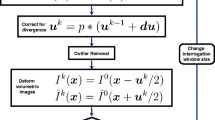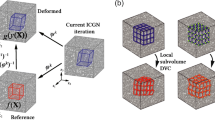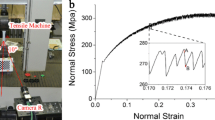Abstract
Digital volume correlation (DVC) has evolved into a powerful tool for quantifying full-field internal deformation. In existing subvolume-based local DVC, subvolume size and shape function are two key user-defined parameters closely related to the DVC measurement errors. In routine implementation, the user must define fixed subvolume size and shape function according to prior experience and intuition, which cannot ensure accurate measurements, particularly for unknown complex heterogeneous deformation fields. Self-adaptive selection of optimal subvolume size and the best shape function is therefore highly desirable to realize full-automatic and quality DVC measurements. In this work, we first establish theoretical error models that relate total displacement errors to subvolume sizes and shape functions. By minimizing the V-shaped models of theoretically predicted total errors, optimal subvolume size and the best shape function can be identified as inputs for self-adaptive DVC analysis at each calculation point. The accuracy advantage of the presented self-adaptive DVC approach over classic one using fixed subvolume size and shape function is demonstrated through numerically simulated three-point bending tests.










Similar content being viewed by others
References
Bay BK, Smith TS, Fyhrie DP et al (1999) Digital volume correlation: three-dimensional strain mapping using X-ray tomography. Exp Mech 39(3):217–226
Pan B, Qian K, Xie H, Asundi A (2009) Two-dimensional digital image correlation for in-plane displacement and strain measurement: a review. Meas Sci Technol 20(6):062001
Pan B (2018) Digital image correlation for surface deformation measurements: historical developments, recent advances and future goals. Meas Sci Technol 29(8):082001
Bay BK (2008) Methods and applications of digital volume correlation. J Strain Anal Eng Des 43(8):745–760
Fedele R, Ciani A, Fiori F (2014) X-ray microtomography under loading and 3D-volume digital image correlation. A review. Fund Inform 135(1–2):171–197
Roberts BC, Perilli E, Reynolds KJ (2014) Application of the digital volume correlation technique for the measurement of displacement and strain fields in bone: a literature review. J Biomech 47(5):923–934
Buljac A, Jailin C, Mendoza A, Neggers J, Taillandier-Thomas T, Bouterf A et al (2018) Digital volume correlation: review of Progress and challenges. Exp Mech 58(5):661–708
Borsdorf A, Raupach R, Flohr T, Hornegger J (2008) Wavelet based noise reduction in CT-images using correlation analysis. IEEE Trans Med Imaging 27(12):1685–1703
Momose A, Takeda T, Itai Y, Hirano K (1996) Phase-contrast X-ray computed tomography for observing biological soft tissues. Nat Med 2(4):473–475
Boas FE, Fleischmann D (2012) CT artifacts: causes and reduction techniques. Imaging Med 4(2):229–240
Verhulp E, van Rietbergen B, Huiskes R (2004) A three-dimensional digital image correlation technique for strain measurements in microstructures. J Biomech 37(9):1313–1320
Jandejsek I, Jiroušek O, Vavřík D (2011) Precise strain measurement in complex materials using digital volumetric correlation and time lapse micro-CT data. Procedia Eng 10:1730–1735
Leclerc H, Périé JN, Roux S, Hild F (2011) Voxel-scale digital volume correlation. Exp Mech 51(4):479–490
Pan B, Wu D, Wang Z (2012) Internal displacement and strain measurement using digital volume correlation: a least-squares framework. Meas Sci Technol 23(4):045002
Pan B, Wang B, Wu D, Lubineau G (2014) An efficient and accurate 3D displacements tracking strategy for digital volume correlation. Opt Lasers Eng 58:126–135
Pan B, Wang B (2017) A flexible and accurate digital volume correlation method applicable to high-resolution volumetric images. Meas Sci Technol 28(10):105007
Wang B, Pan B (2018) Incremental digital volume correlation method with nearest subvolume offset: an accurate and simple approach for large deformation measurement. Adv Eng Softw 116:80–88
Gomes Perini LA, Passieux JC, Périé JN (2014) A multigrid PGD-based algorithm for volumetric displacement fields measurements. Strain 50(4):355–367
Schreier HW, Sutton MA (2002) Systematic errors in digital image correlation due to undermatched subset shape functions. Exp Mech 42(3):303–310
Lu H, Cary PD (2000) Deformation measurements by digital image correlation: implementation of a second-order displacement gradient. Exp Mech 40(4):393–400
Yu L, Pan B (2015) The errors in digital image correlation due to overmatched shape functions. Meas Sci Technol 26(4):045202
Wang B, Pan B (2015) Random errors in digital image correlation due to matched or overmatched shape functions. Exp Mech 55(9):1717–1727
Xu X, Su Y, Zhang Q (2017) Theoretical estimation of systematic errors in local deformation measurements using digital image correlation. Opt Lasers Eng 88:265–279
Pan B, Xie H, Wang Z, Qian K, Wang Z (2008) Study on subset size selection in digital image correlation for speckle patterns. Opt Express 16(10):7037–7048
Wang YQ, Sutton MA, Bruck HA, Schreier HW (2009) Quantitative error assessment in pattern matching: effects of intensity pattern noise, interpolation, strain and image contrast on motion measurements. Strain 45(2):160–178
Wang Y, Lava P, Reu P, Debruyne D (2016) Theoretical analysis on the measurement errors of local 2D DIC: part I temporal and spatial uncertainty quantification of displacement measurements. Strain 52(2):110–128
Yuan Y, Huang J, Peng X, Xiong C, Fang J, Yuan F (2014) Accurate displacement measurement via a self-adaptive digital image correlation method based on a weighted ZNSSD criterion. Opt Lasers Eng 52:75–85
Gates M, Gonzalez J, Lambros J, Heath MT (2015) Subset refinement for digital volume correlation: numerical and experimental applications. Exp Mech 55(1):245–259
Wittevrongel L, Lava P, Lomov SV, Debruyne D (2015) A self adaptive global digital image correlation algorithm. Exp Mech 55(2):361–378
Pan B, Wang B (2016) Digital image correlation with enhanced accuracy and efficiency: a comparison of two subpixel registration algorithms. Exp Mech 8(56):1395–1409
Pan B (2013) Bias error reduction of digital image correlation using Gaussian pre-filtering. Opt Lasers Eng 51(10):1161–1167
Pan B, Lu Z, Xie H (2010) Mean intensity gradient: an effective global parameter for quality assessment of the speckle patterns used in digital image correlation. Opt Lasers Eng 48(4):469–477
Pan B, Asundi A, Xie H, Gao J (2009) Digital image correlation using iterative least squares and pointwise least squares for displacement field and strain field measurements. Opt Lasers Eng 47(7):865–874
Tai SC, Yang SM (2008) A fast method for image noise estimation using Laplacian operator and adaptive edge detection. In Communications, Control and Signal Processing, 2008. ISCCSP 2008. 3rd International Symposium on. IEEE, pp 1077–1081
Murphy MJ, Wei Z, Fatyga M, Williamson J, Anscher M, Wallace T, Weiss E (2008) How does CT image noise affect 3D deformable image registration for image-guided radiotherapy planning? Med Phys 35(3):1145–1153
Fu J, Pierron F, Ruiz PD (2013) Elastic stiffness characterization using three-dimensional full-field deformation obtained with optical coherence tomography and digital volume correlation. J Biomed Opt 18(12):121512
Valle V, Bokam P, Germaneau A, Hedan S (2018) New development of digital volume correlation for the study of fractured materials. Exp Mech:1–15. https://doi.org/10.1007/s11340-018-0415-2
Bar-Kochba E, Toyjanova J, Andrews E, Kim KS, Franck C (2015) A fast iterative digital volume correlation algorithm for large deformations. Exp Mech 55(1):261–274
Acknowledgements
This work is supported by the National Natural Science Foundation of China (NSFC) (11872009, 11632010), the National Key Research and Development Program of China (2018YFB0703500), the Aeronautical Science Foundation of China (ASFC) (2016ZD51034), and State Key Laboratory of Traction Power of Southwest Jiaotong University (Grant No. TPL1607).
Author information
Authors and Affiliations
Corresponding author
Appendix: Undermatched Bias Error Model in DVC Using 2nd-Order Shape Function
Appendix: Undermatched Bias Error Model in DVC Using 2nd-Order Shape Function
According to the objective function given in Eq. (4), we first define the following parameters to facilitate subsequent derivation
The derivative of Eq. (4) with respect to x-directional 10 deformation parameters can be written as
Simplifying above equation yields the following expression
One can derive the following formula by solving the above equation
Based on the forth-order Taylor expansion of u (x + i, y + j, z + k), we can obtain
where parameters E, F and G are defined as
Finally, displacement systematic error eu in DVC using 2nd-order shape function can be estimated as
Rights and permissions
About this article
Cite this article
Wang, B., Pan, B. Self-Adaptive Digital Volume Correlation for Unknown Deformation Fields. Exp Mech 59, 149–162 (2019). https://doi.org/10.1007/s11340-018-00455-2
Received:
Accepted:
Published:
Issue Date:
DOI: https://doi.org/10.1007/s11340-018-00455-2




